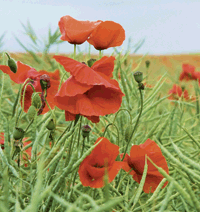OSR growers must plan now for life without trifluralin

The loss of trifluralin may mean that weed control in oilseed rape crops needs a rethink this year. Louise Impey reports
Trifluralin controlled a number of weeds but, while its activity on some was well known, its control of others may only become apparent now that it has gone.
That means oilseed rape growers will have to do some serious thinking this year. Dick Neale, technical manager with Hutchinsons, says: “It did a good job, at a low cost.
“Growers with weeds like poppies, cleavers and cranesbill to control will have to find an alternative solution, while blackgrass populations may also need checking.”
Poppies germinate in both the autumn and the spring, making cultural control impossible. “In any case, with winter oilseed rape there’s no time to use these techniques,” he adds. “The crop has to be established in good seed-beds while conditions are right.”
Metazachlor mixes offer good base line control of both broadleaved and grass weeds, advises Mr Neale. “Metazachlor can pick up poppies, but it’s a bit hit or miss and the results can be very variable. Where they are a particular issue, you need to use quinmerac as well.”
He recommends a pre-emergence application of Oryx or Novall (metazachlor+ quinmerac), which will also help with cleavers control.
“What growers have to remember with metazachlor is that they need to maintain a reasonable dose for broad spectrum weed control. That means applying between 750g and 1000g.”
From autumn 2010 onwards, there will be restrictions on metazachlor use, he reports. “Growers will only be allowed to use a total of 1000g in a three-year period. And that must be applied in just one application.”
For most, that won’t be a problem, believes Mr Neale. “It’s a workable solution to the water quality issue. Very few farms are growing oilseed rape more frequently than that.”
Getting good pre-emergence control is important where poppies, cleavers and cranesbill are concerned, he adds. “The herbicide needs to be on ahead of anything emerging. So that’s within two or three days of getting the crop in the ground.”
Previous reluctance to spend on herbicides until the crop has established is not an option now that trifluralin has gone, he warns.
“It has to be the right product, applied pre-emergence at the right dose,” he stresses. “The post-emergence options are less successful, although they can help if you’ve been unable to travel.”
Galera (picloram+clopyralid) will suppress poppies when applied in the autumn, although its real value comes in the spring for tidying up cleavers, groundsel and mayweed, he continues.
Another post-emergence choice is Fox or Sabine (bifenox), which has an off-label approval for use in oilseed rape. “It will suppress poppies, but it needs wetting well to do it. And there can be quite a bit of crop damage if it’s used when the rape plants are small.”
Mr Neale’s advice is to wait until the rape plants are big enough and to avoid complex tank mixes.
“Apply it when the plants are past the six leaves stage and use an oil. It will really damage poppies, but it is used at the grower’s risk.”
Blackgrass suppression is delivered by metazachlor, so the pre-emergence treatment will do a holding job until Kerb can be applied, he adds.
“This year is the one to sit down with your agronomist, decide which weeds are important and then agree your approach.”
Scotland
In Scotland, Dr Keith Dawson of SAC agrees that pre-emergence control is better for both cleavers and poppies.
“This puts a greater onus on producing good seed-beds,” he says. “The key to good results with these pre-emergence herbicides is putting them on at the optimum time in the right conditions.”
The post-emergence options are few and far between, he points out. “And growers were penalised for admixture last year, so there’s a need to get it right.”
He suggests a metazachlor/clomazone mix (as in Nimbus) as a good replacement for trifluralin. “It works well and fills in the gaps left. But it will cost growers more.”
Dr Dawson adds that growers must be careful with different soil types. “It takes finesse to be successful with this type of product.”
Where broadcasting is the preferred option at drilling, seeds are more vulnerable to herbicide damage, he notes.
Metazachlor products
- Butisan S – metazachlor)
- Nimbus – metazachlor + clomazone)
- Novall – metazachlor + quinmerac)
- Oryx – metazachlor + quinmerac)
- Shadow – metazachlor + dimethenamid + quinmerac)
- Springbok – metazachlor + dimethenamid)

